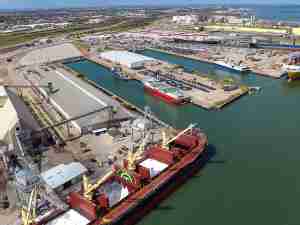The Long Beach Board of Harbor Commissioners on Monday voted 4-1 to approve an exemption from the Clean Truck Fund Rate for the cleanest natural gas-powered trucks, as a transitional step to a future when zero-emissions cargo trucks are widely available.
Natural gas trucks are lower emitters of nitrogen oxides, a building block of smog, and provide a step toward cleaner air as the Port strives for the goals of the San Pedro Bay Ports Clean Air Action Plan.
In considering a rate to encourage the trucking industry to invest in cleaner vehicles and reach zero-emissions for cargo trucking by 2035, the Port of Long Beach and Port of Los Angeles have set a rate of $10 per twenty-foot equivalent unit – a standard measure for one 20-foot-long cargo container. The Ports have not yet implemented that rate, but are working on a system with a third-party vendor that will collect the rate for the ports.
Zero-emissions trucks had already been determined to be exempt from the future rate. Monday’s action by Long Beach is designed to encourage the industry to make an interim step while zero-emissions technology catches up.
“These trucks will emit 90% less nitrogen oxides than equivalent vehicles today,” said Port of Long Beach Executive Director Mario Cordero. “The question we were asking ourselves was do we reduce emissions now or do we wait for tomorrow? For our community, and our commitment to the Clean Air Action Plan, the answer is now.”
“The Port of Long Beach is the Green Port, a trailblazer in sustainable goods movement,” said Commission President Frank Colonna. “We remain confident that we can encourage the use of cleaner natural gas trucks now, and also nurture the technology that will allow us to meet our goal of a zero-emissions drayage truck fleet by 2035. To get there, we must start the journey.”
The low nitrogen oxides exemption will apply to trucks picking up or dropping off loaded containers at the Port of Long Beach that use natural gas engines meeting the 0.02 grams of nitrogen oxides per brake horsepower-hour standard. The vehicles must be purchased and registered in the Port Drayage Truck Registry by Dec. 31, 2022.
Phasing out older, more polluting trucks has been key to clean air gains the San Pedro Bay ports have made since the original Clean Truck Program was launched in 2008. Diesel emissions from trucks have been cut by as much as 97% compared to 2005 levels. Trucks remain the port's largest source of greenhouse gas emissions and the second highest source of nitrogen oxides, a contributor to regional smog formation.
The Clean Air Action Plan (CAAP) has established a goal of zero-emissions trucks by 2035. A key component of the overall strategy to transition to a zero-emissions truck fleet is an updated Clean Truck Program incentivizing the development and adoption of new technology. The Clean Truck Fund rate is expected to generate $80 million in the first year.
Updated in 2017, the CAAP contains a comprehensive strategy to accelerate progress toward a zero-emissions future while protecting and strengthening the ports’ competitive position in the global economy. Since 2005, port-related air pollution emissions in San Pedro Bay have dropped 87% for diesel particulate matter, 58% for nitrogen oxides and 97% for sulfur oxides. Targets for reducing greenhouse gases (GHGs) from port-related sources were introduced as part of the 2017 CAAP Update. The document calls for the ports to reduce GHGs to 40% below 1990 levels by 2030 and 80% below 1990 levels by 2050. The CAAP was originally approved in 2006.










